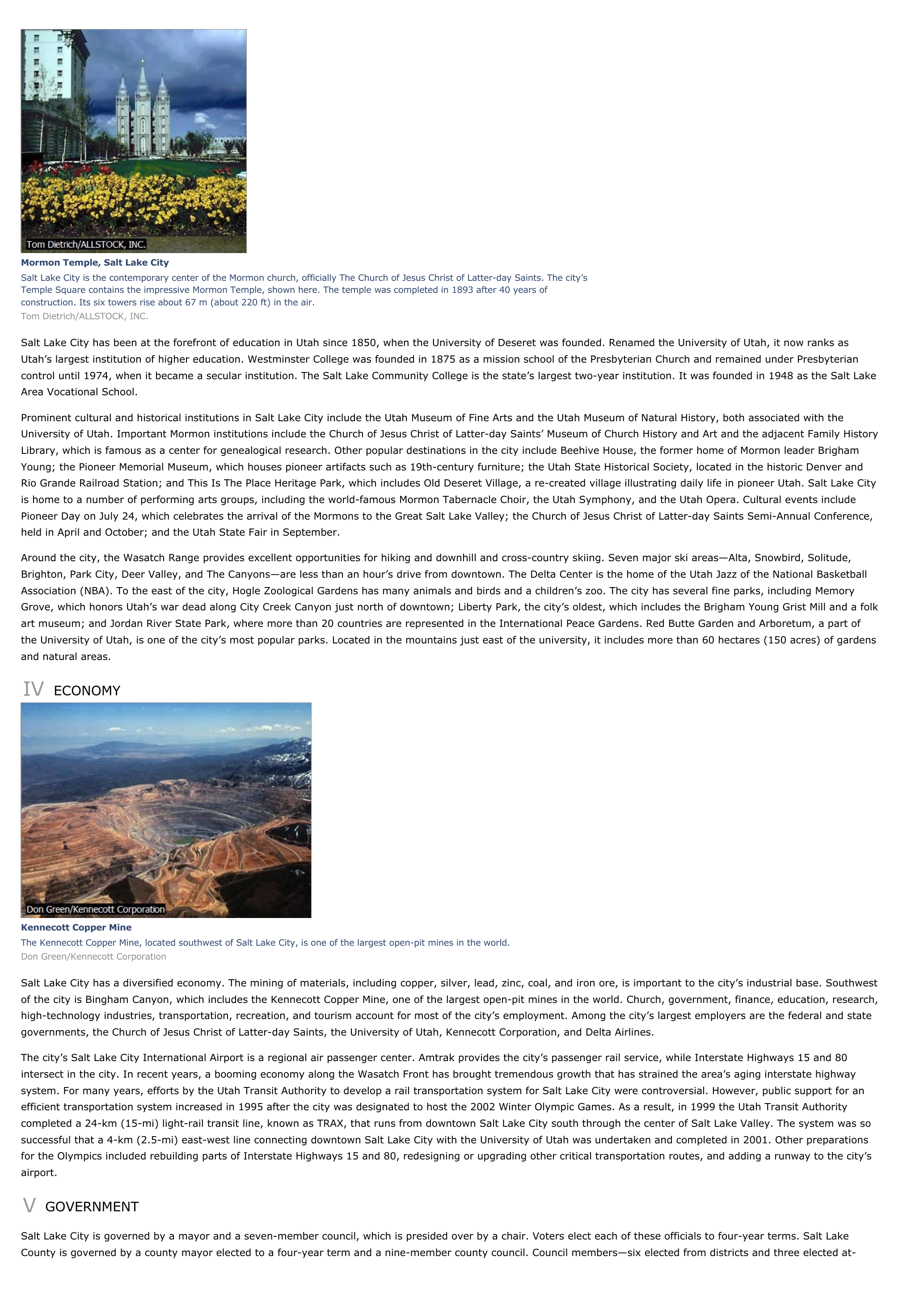Salt Lake City - geography.
Publié le 27/05/2013

Extrait du document
«
Mormon Temple, Salt Lake CitySalt Lake City is the contemporary center of the Mormon church, officially The Church of Jesus Christ of Latter-day Saints.
The city’sTemple Square contains the impressive Mormon Temple, shown here.
The temple was completed in 1893 after 40 years ofconstruction.
Its six towers rise about 67 m (about 220 ft) in the air.Tom Dietrich/ALLSTOCK, INC.
Salt Lake City has been at the forefront of education in Utah since 1850, when the University of Deseret was founded.
Renamed the University of Utah, it now ranks asUtah’s largest institution of higher education.
Westminster College was founded in 1875 as a mission school of the Presbyterian Church and remained under Presbyteriancontrol until 1974, when it became a secular institution.
The Salt Lake Community College is the state’s largest two-year institution.
It was founded in 1948 as the Salt LakeArea Vocational School.
Prominent cultural and historical institutions in Salt Lake City include the Utah Museum of Fine Arts and the Utah Museum of Natural History, both associated with theUniversity of Utah.
Important Mormon institutions include the Church of Jesus Christ of Latter-day Saints’ Museum of Church History and Art and the adjacent Family HistoryLibrary, which is famous as a center for genealogical research.
Other popular destinations in the city include Beehive House, the former home of Mormon leader BrighamYoung; the Pioneer Memorial Museum, which houses pioneer artifacts such as 19th-century furniture; the Utah State Historical Society, located in the historic Denver andRio Grande Railroad Station; and This Is The Place Heritage Park, which includes Old Deseret Village, a re-created village illustrating daily life in pioneer Utah.
Salt Lake Cityis home to a number of performing arts groups, including the world-famous Mormon Tabernacle Choir, the Utah Symphony, and the Utah Opera.
Cultural events includePioneer Day on July 24, which celebrates the arrival of the Mormons to the Great Salt Lake Valley; the Church of Jesus Christ of Latter-day Saints Semi-Annual Conference,held in April and October; and the Utah State Fair in September.
Around the city, the Wasatch Range provides excellent opportunities for hiking and downhill and cross-country skiing.
Seven major ski areas—Alta, Snowbird, Solitude,Brighton, Park City, Deer Valley, and The Canyons—are less than an hour’s drive from downtown.
The Delta Center is the home of the Utah Jazz of the National BasketballAssociation (NBA).
To the east of the city, Hogle Zoological Gardens has many animals and birds and a children’s zoo.
The city has several fine parks, including MemoryGrove, which honors Utah’s war dead along City Creek Canyon just north of downtown; Liberty Park, the city’s oldest, which includes the Brigham Young Grist Mill and a folkart museum; and Jordan River State Park, where more than 20 countries are represented in the International Peace Gardens.
Red Butte Garden and Arboretum, a part ofthe University of Utah, is one of the city’s most popular parks.
Located in the mountains just east of the university, it includes more than 60 hectares (150 acres) of gardensand natural areas.
IV ECONOMY
Kennecott Copper MineThe Kennecott Copper Mine, located southwest of Salt Lake City, is one of the largest open-pit mines in the world.Don Green/Kennecott Corporation
Salt Lake City has a diversified economy.
The mining of materials, including copper, silver, lead, zinc, coal, and iron ore, is important to the city’s industrial base.
Southwestof the city is Bingham Canyon, which includes the Kennecott Copper Mine, one of the largest open-pit mines in the world.
Church, government, finance, education, research,high-technology industries, transportation, recreation, and tourism account for most of the city’s employment.
Among the city’s largest employers are the federal and stategovernments, the Church of Jesus Christ of Latter-day Saints, the University of Utah, Kennecott Corporation, and Delta Airlines.
The city’s Salt Lake City International Airport is a regional air passenger center.
Amtrak provides the city’s passenger rail service, while Interstate Highways 15 and 80intersect in the city.
In recent years, a booming economy along the Wasatch Front has brought tremendous growth that has strained the area’s aging interstate highwaysystem.
For many years, efforts by the Utah Transit Authority to develop a rail transportation system for Salt Lake City were controversial.
However, public support for anefficient transportation system increased in 1995 after the city was designated to host the 2002 Winter Olympic Games.
As a result, in 1999 the Utah Transit Authoritycompleted a 24-km (15-mi) light-rail transit line, known as TRAX, that runs from downtown Salt Lake City south through the center of Salt Lake Valley.
The system was sosuccessful that a 4-km (2.5-mi) east-west line connecting downtown Salt Lake City with the University of Utah was undertaken and completed in 2001.
Other preparationsfor the Olympics included rebuilding parts of Interstate Highways 15 and 80, redesigning or upgrading other critical transportation routes, and adding a runway to the city’sairport.
V GOVERNMENT
Salt Lake City is governed by a mayor and a seven-member council, which is presided over by a chair.
Voters elect each of these officials to four-year terms.
Salt LakeCounty is governed by a county mayor elected to a four-year term and a nine-member county council.
Council members—six elected from districts and three elected at-.
»
↓↓↓ APERÇU DU DOCUMENT ↓↓↓
Liens utiles
- Salt Lake City - geography.
- Salt Lake City.
- Borzage Frank, 1893-1962, né à Salt Lake City, cinéaste américain.
- Borzage (Frank) Metteur en scène de cinéma américain (Salt Lake City, 1893 - Hollywood, 1963).
- États-Unis. Salt Lake City, le Capitole.

































